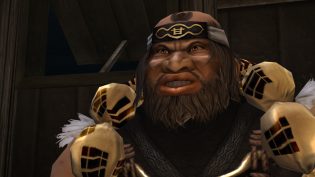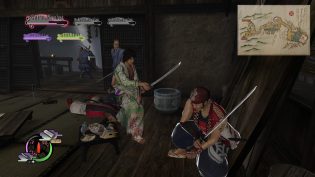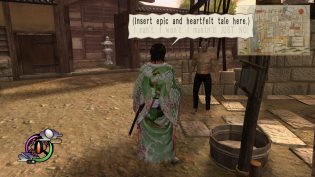I’ve long been interested in checking Way of the Samurai titles, since they all looked like very curious attempts at mixing open world design which promises that you can “be whomever you want to be” with action adventure and choose your own adventure type non-linear storytelling. And they are. And turned out I wasn’t really in the mood for how exactly they implemented these ideas. But they are certainly a curious beast I want to write a bit about.
Both Way of the Samurai 3 and 4 follow the same basic principles – you start of as a samurai with little or no money, resources and renown and basic skills and weapons. There’s an open ended location divided into separate areas and several powers in conflict. And, of course, you can join in with any of those powers, switch alliances on the fly or, if you’re skilled and in the especially bad mood, kill everyone. But note that once you die, you die. You can always just leave as well. Which is where the rogue-lite new game plus systems kick in since you can keep everything between playthroughs and, in fact, following the storyline is easier and meant to be done after you grind like this a bit. Or go for easier endings, since there are tons of them. There’s a basic day and night system, ability to eat food (for healing and other various effects), world reacts to what you do and how you behave and all in all this is almost a perfect set up for a truly open-ended storytelling, that achieves much more that lots of other games I saw the promise of “be anyone you want”, since unlike those games your being anyone doesn’t rely on game world being in constant status quo which barely registers what you do. It’s still not particularly detailed and some interactions may be stupid based on how you change what you say or do, but it’s still one of the most impressive examples of such approach I’ve ever seen.
The main differences between these two games are very easy to spot. Way of the Samurai 3 tries to keep it’s open ended nature in everything. It’s actually not a long game to get to the ending, even by accident. And it just effectively dumps you into a game world without explaining much. But all of that is done simply to enhance the feeling that you can influence anything and everything at any given time. For that, there’re two dedicated buttons that work even in the dialogue, seriously reminding me of the Mass Effect 2 dialogue interrupts – a game that came out about a year later. Basically, you can unsheathe/sheathe the sword with one button, even as an interruption of a dialogue or a cutscene, or you can press the “drop to knees and apologize” button. And it’s a really neat little touch that makes the game feel more interactive. In addition, the day/night system is constantly in effect, with a lot of actions like quick travel taking time, but all story events (“inklings”) being triggered by the player when they feel like they’re ready, instead of just happening on their own. It’s also worth mentioning here, that WotS 3 feels more or less grounded in reality, with dramatized, but as if based on real events characters and events, which adds to its flavor. Though it has its share of stupidity.
Way of the Samurai 4, on the other hand, tries to be much more user-friendly. It starts off with a more hand-holding almost tutorial like events, drops real time day/night system instead switching the time usage to specific actions (but introducing stamina for similar actions as what Time took previously) and makes the game feel a bit more… guided as a result. There’s a still a bunch of grind if you want to get to an ending, each of which now takes longer to achieve. And damn if it wasn’t all over the top and anime. You have terrible caricatures of British forces, ridiculous accents and outfits and dialogue usually not taking itself seriously at all. It is easier to get into and play, and not fail, of course, but it is also, in my opinion, a bit too silly and removes some of the nice idea from the previous game to be a straight up improvement, more like a different take on the similar idea.
And I really wasn’t in a mood to complete them, properly. I got to one ending in 3, almost by accident since the enemy I had to face should’ve killed me, except I managed to stunlock his AI. If you are in the mood of checking the “live your story your way” types of games and want to spend several hours restarting the story to get things different, this is definitely the series to check.







